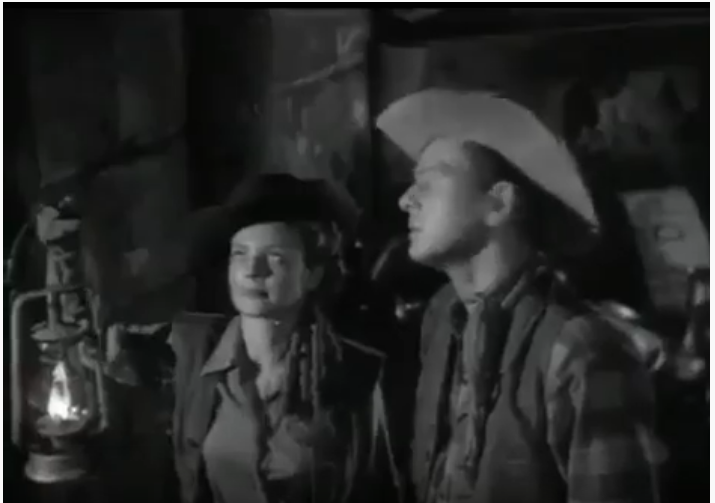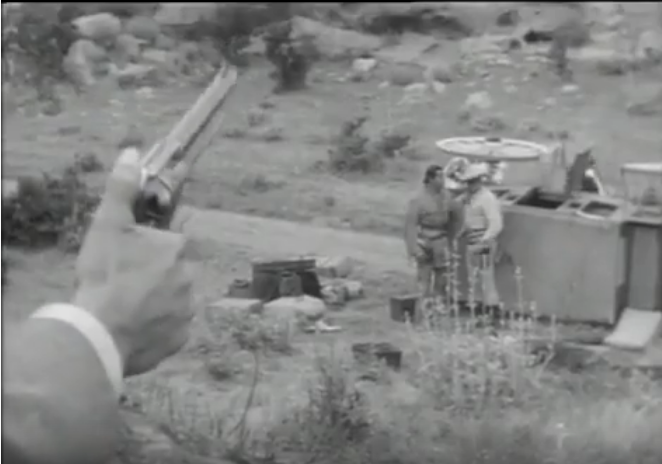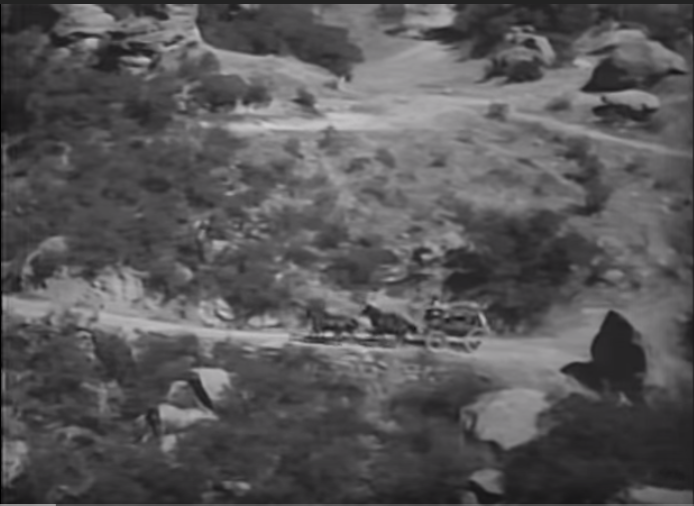What I watched: Five episodes of The Lone Ranger, a kid-oriented Western created by George W. Trendle. All episodes starred Clayton Moore as the Ranger and Jay Silverheels as Tonto, and aired on ABC at 7:30 on Thursday nights. The YouTube channel that I was getting most of the episodes from has been taken down, but I’ve found another one with most of them up, so that’s… good.
The episode begins on an unusually morose note, with old Tug Barker about to be executed at San Pablo prison before it is closed. He gives his young bunkmate Danny a bird to deliver to his daughter. When Danny collapses from the heat, the Ranger and Tonto rescue him, and learn about the injustice that lead to the old man’s execution. We are also introduced to this episode’s bad guys, the real murderer Gil and a crooked lawyer Hague.
Danny delivers the cage to Tug’s daughter Nora, but he’s confronted by Gil, who turns out to also be Nora’s suitor. Small world. Tonto does his “wild Indian act” to distract them by wrecking shit. There’s a dissertation to be written about that scene. He goes to prison, and the bad guys interrogate him about an old cache of gold underneath the now-closed prison. Tug’s bird cage also contains a letter saying that he discovered a cache of gold, left by Spanish settlers, underneath San Pablo.

Hague and Gil meet, and start discussing their plan. The Ranger and Tonto get the drop on them, but let them go, doing one of their signature schemes. They follow the baddies to the prison, and Gil starts getting spooked by the memory of Tug. Danny and Nora re also there, and have found the gold, but Hague and Gil pull the ladder up on them and trap them. But they too are being watched by the Ranger and Tonto, who punch them out. Thus, their needlessly circuitous plan is complete, and Nora and Danny take the gold home.
Of note in this episode is Tonto consciously invoking a racial stereotype by doing his “wild Indian” act. In a different context, this could come off as a self-reflexive construct about the performative nature of race. But this is The Lone Ranger, so beneath the wild Indian act is another racial type, the subservient sidekick who has no problem being tossed in jail to cause a momentary distraction. This is perhaps emblematic of The Lone Ranger‘s treatment of race: striving to reject the racial stereotypes of cruder Western, but still unable to picture Indigenous people as complete humans.
“Damsels in Distress” (June 8, 1950, writ. Tom Seller, feat. John Banner, Tom Tyler, Phil Tead, Peggy McIntire, Gloria Winters)
We open with a group of nebulous Europeans, lead by a man named Garth, trying to buy a newly-designed rifle off the inventor Dexter. He says no, as there are too many wars in Europe. He’s really concerned about the revolutions of 1848, I guess. Dexter breaks his rifle and runs away, but gets an off-screen thrown knife in the back for his trouble. The Ranger and Tonto come along and take care of him before he passes. It turns out that Garth is also wanted as a foreign agent.
The blueprints for the gun are now in the hands of Dexter’s two daughters and their governess. Garth and von Baden see them leaving the house, then ransack the place, intimidating their servant, and learn that the women have left with them. The Ranger decides to use this as an excuse to disguise himself as an old soldier. He and von Baden both hop into a stagecoach with the women. This is the worst ripoff of Stagecoach I’ve ever seen.

Garth then acts as a robber, trying to steal from the stage, while von Baden fights him off. This ruse fools the women, who are all credulous enough to tell him where they’ve hidden the drawing and hand them over to them, except for the youngest girl, who apparently has two brain cells to rub together. von Baden then pulls a gun on them, but the Ranger gets the jump on him with the old “there’s a knife on the floor” trick. Garth tosses him out, but he and Tonto chase down the evil foreigner and kick his ass. Presumably they sell the rifle patent and make a lot of guns to be used in good old-fashioned American wars.
This episode has brief glimpses of the more adult Westerns that would come to dominate prime time later in the decade. Here we have a justice system that actually kills an innocent man, and the geopolitics of American involvement in Europe interjected into the Old West. The villain is a European, heavily implied to be German, and he is determined to involve the innocent Americans in European wars. The need to stop a dangerous weapon from falling into the wrong hands also has particular resonance in a Cold War environment. It’s not much, and it’s mostly just a backdrop to some Western shenanigans, but it’s something.
The role of Spanish gold in this story, and many others, is also interesting to me. The gold is, of course, remnants of the original conquest of the New World, one that America honours in its very name. In addition to being a convenient plot device, the Americans obtaining the gold establishes them as the legitimate heirs of those early colonization efforts, while being conveniently innocent of any of the bloodshed that was necessary to acquirer these goals.
The Ranger and Tonto stumble upon yet another overturned stagecoach, apparently attacked by “Indians” and then get shot at by a teen. Because this is still the first act, they decide to be friends with the guy trying to kill them. It turns out that the kid, Jim (Jones), ran away from his mom in St. Louis to go join his dad (Dunn) in the West.
The head of the local cattle ranchers, and obvious villain, Tom Gorham (Harrison) comes by. He’s the titular “man without a gun”, but he seems excited to round up a posse and go after the Indians. The Lone Ranger, having been in this show before, thinks that the attack is suspicious and the Indians aren’t the real bad guy. Gorham’s plan is to start a war and somehow get the rights to a gold mine under chieftan Red Hawk’s territory.

The Ranger rides in to parlay with Red Hawk. He quickly realized that the attack was staged by the true villain: the white man. A bunch of Gorham’s men dressed as Indians attack Jim and his dad, and take the boy and Tonto hostage while being majorly problematic. Tom wants to use this as a pretext to attack the reservation. Gorham’s henchman reveals the plan to a tied-up Tonto and Jim, which they call him on. The goon is going to shoot them with a bow, but the Ranger comes in and punches everyone to save the day. Jim’s dad decides to let him stay on the ranch, and presumably be exposed to further violence.
“Man Without a Gun” is written and directed by unfamiliar names, as I believe this is Richardson and Morse’s first credit on the show. And yet, this is as archetypical as a Lone Ranger episode you’ll ever see, from the opening stage coach robbery to the expository dialogue between the secret villain and his minion to the heroes riding away immediately at the end. It was still only the first season, but with almost two decades of stories in the broader franchise, The Lone Ranger was at this point a vehicle pretty much anyone could drive.
-nice perspective shot from hidden gunman (0:01)
We open with a banker foreclosing on the property of a young man named Morrison (Hanson) who happens to be sheriff. Those damn sub-prime mortgages. This is apparently on orders from a bad guy named Conent (Blake), who killed the previous sale. He asks for the mortgage to be extended for one week so that he can call in the Lone Ranger to settle the problem. This must be where he turns into the “Loan Arranger” guy I see on TV. Conent, a snazzily-dressed fellow holding a cigar, tries to bribe Morrison, but wouldn’t you know it, he’s an upstanding citizen.
Conent takes a more direct approach, kidnapping Morrison and making him leave a note suggesting he’s taken the money and skipped town. The bad guys have sent money to his creditors and everything The Ranger and Tonto arrive to find this, and Morrison’s slightly loopy wife. They’re still convinced that the sheriff is a good guy, given the Ranger’s infallible eye for character.

Conent has Morrison has tied up at his hide-out. Morrison says he has a friend rounding up information about a previously unmentioned murder. Conent’s goon goes out and get ambushed by the Ranger and Tonto, giving up the location his hide-out. The Ranger gets the drop on the bad guy, but he presses a switch that opens up a secret passage with a goon behind it. This seems needlessly elaborate. But the Ranger has his own hidden goon (Tonto) and they easily subdue the baddies. So Morrison is safe, with his debts paid off too. I wish I could be in a Lone Ranger episode.
This is probably one of the more elaborate plans that a Lone Ranger villain hatches. Again land, and the possession of it, is central to the conflict. The series puts great stock in property and the rule of law, but is also constantly afraid of this rule of law being undermined. The solution to this, it posits, is a second violent factor outside of the scope of the law, but this time benevolent.
We open with the familiar sight of a man on death row, scheduled to hang in the morning, but this time he’s actually a bad guy. He’s Clay Derpy (not the actual spelling, but that’s what I heard, so I’m sticking with it), and he’s counting on his still-at-large brother to bust him out. His brother Stark (Jolley) is out robbing stagecoaches, the other Lone Ranger episode opening. The stage contains two of the governor’s female relatives (Neumann and England), revealed through some awful expository dialogue. Fortunately the Ranger and Tonto are on the scene to chase them off.
Scott’s idea is to follow the titular “eye for an eye” proverb by capturing the governor’s family. They’re a sensible younger woman and a stuffy, foolish older woman. The goons have heard about the Ranger and are scared of him. The girls and our heroes dress in culturally insensitive Mexican costumes (9:00) The goons set a blockade but the old woman gets them out of trouble with some Spanish.

Eventually the bad guys get wise to the plan by browbeating the friendly Mexican who helped the heroes disguise themselves (the Ranger saying “yo quiero Taco Bell” probably didn’t help.) They kidnap the girls and leave the Ranger and Tonto in a ditch. The good guys find Derpy’s hideout. The women help out by literally pulling the rug out from under the villain, and the Ranger bludgeons him with a fireplace poker. The state’s ability to kill has been restored, and all is well in the world.
This is the second episode this month that features multiple women being placed in peril, who are neatly divided into spunky heroines and irritating old maids. For the show’s pubescent male audience, this could have been engaging, neatly parsing out their growing interest in girls from their annoyance with femininity. Of course, grown men often think of women and girls the same way.
Overall Thoughts: One thing that really stood out to me watching these episodes was the ease and frequency with which people in The Lone Ranger universe point guns at and shoot at each other. Frequently this threatening with gun violence is only an opening flirtation before quickly joining forces. Maybe there’s something phallic in this, or maybe it’s just American gun culture. Guns don’t seem to hurt people much in this universe anyway, so maybe it’s natural that people are easy on the trigger.
The same theme of gun ownership pops up in “Man Without a Gun”, where the eponymous villain’s apparent pacifism is the first sign that he is suspicious. Rather than the simple, straightforward aggression of the gun-owners, he is a schemer who exploits the power of others. Gorham’s unarmed nature is not particularly well developed, but his character almost seems to be a defense of the series’ play-violence: better a Ranger who shoots and punches, it suggests, than one who relies on others. (Again, you could also see a geopolitical reference to the Soviet Union’s professions of non-involvement while its surrogate armies battled the US across the world.)
Perhaps this was just a way of adding a little bit of action into the talkier sections of the episodes. But it also reflects the broader conception of guns in American culture, particularly in the South, as a harmless and almost playful component of robust masculinity. It is this conception that causes so much furor in American discussions about gun violence, with the fetishistic character of the gun as a symbol of rural masculinity and self-determination making it either sacred or reviled. After all, who needs to fear when you have the Lone Ranger, the archetypical “good guy with a gun”, right around the corner?
Also, I need a better title for the “overall thoughts” section. Some kind of TV reference…
Coming up next: Howdy Doody celebrates the Fourth of July, America’s version of Canada Day.






